
AAVMC rolls out program designed to ensure veterinary graduates are prepared for practice
AAVMC has developed a set of core competencies for the benefit of future veterinarians.
Dr. Jason Frank of the Royal College of Physicians and Surgeons of Canada opened the Saturday morning session on Competency-Based Veterinary Education with a discussion on human medical education. (Photo courtesy of AAVMC)A new
The CBVE program purports to be an outcomes-based, learner-centered approach to veterinary medical education that uses a shared framework and language to help ensure that every veterinary medical college student graduates with competencies that enable them to be successful from their first day as independent veterinarians.
“This framework, which represents the latest pedagogical thinking and best practices, lays the foundation for colleges and schools to develop competency-based education,” says Andrew T. Maccabe, DVM, MPH, JD, CEO of the AAVMC, in the release.
“Colleges and schools will benefit from a common language and a more comprehensive picture of graduate outcomes based upon evidenced-based criteria and agreed-upon standards from some of veterinary medicine's best educators and the latest research,” Dr. Maccabe continues. “It's not a final product but a first step in a journey of co-creation.”
The framework outlines a series of competencies that are considered core as well as subcompetencies that veterinary medical colleges can customize or use as guidelines for assessing veterinary medical students' proficiency.
An outcomes-based, learner-centered approach to education first formally surfaced in the mid-1970s but has only recently gained traction and become a trend, according to Jason Frank, MD, MA(Ed), FRCPC, an expert in competency-based medical education from the Royal College of Physicians and Surgeons of Canada. Dr. Frank opened the CBVE session at the AAVMC annual conference.
The workers in the CBVE working group
Chairs:
- Laura Molgaard, DVM, University of Minnesota
- Jennifer Hodgson, BVSc, PhD, MRCVS, DACVM, Virginia-Maryland College of Veterinary Medicine
Members:
- Harold Bok, DVM, PhD, Utrecht University
- Kristin Chaney, DVM, DACVIM (LAIM), DACVECC, Texas A&M University
- Jan Ilkiw, BVSc, PhD, DECVA, University of California-Davis
- Susan Matthew, BSc(Vet), BVSc, PhD, GradCertEdStud(HigherEd), Washington State University
- Stephen May, MA, VetMB, PhD, DVR, DEO, FRCVS, DECVS, FHEA, Royal Veterinary College
- Emma Read, DVM, MVSc, DACVS, University of Calgary
- Bonnie Rush, DVM, MS, DACVIM, Kansas State University
- Kathleen Salisbury, DVM, MS, DACVS, Purdue University
In 2015, the AAVMC formed the CBVE Working Group, consisting of 10 national and international veterinary medical professors. The working group built on existing frameworks deployed in other areas of health education and incorporated extensive feedback from employer and graduate surveys, the release states.
Since its inception, the working group has logged thousands of emails, over 100 videoconference meetings, 20 face-to-face meetings, 20 stakeholder engagements to gather input and ideas, two formal surveys, multiple expert consultations and communications with the AVMA Council on Education.
The resulting CBVE program seeks to clarify what abilities students need upon graduation and to elucidate steps that demonstrate the progression of expertise. It presents a framework of nine “domains of competence” and outlines specific, observable skills, knowledge, values and attitudes within each domain:
- Clinical reasoning and decision-making
- Individual animal care and management
- Animal population care and management
- Public health
- Communication
- Collaboration
- Professionalism and professional identity
- Financial and practice management
- Scholarship.
It also presents eight “entrustable professional activities” that outline what activities all students should be able perform without supervision in a workplace setting:
- Gather a history, perform an examination and create a prioritized differential diagnosis list.
- Develop a diagnostic plan and interpret results.
- Develop and implement a management/treatment plan.
- Recognize a patient requiring urgent or emergent care and initiate evaluation and management.
- Formulate relevant questions and retrieve evidence to advance care.
- Perform a common surgical procedure on a stable patient, including preoperative and postoperative management.
- Perform general anesthesia and recovery of a stable patient, including monitoring and support.
- Formulate recommendations for preventive healthcare.
The working group is currently developing milestones that represent steps in the mastery of competencies, on a scale from novice to proficient. The CBVE program with downloadable booklets can be found on the AAVMC's website
Newsletter
From exam room tips to practice management insights, get trusted veterinary news delivered straight to your inbox—subscribe to dvm360.




